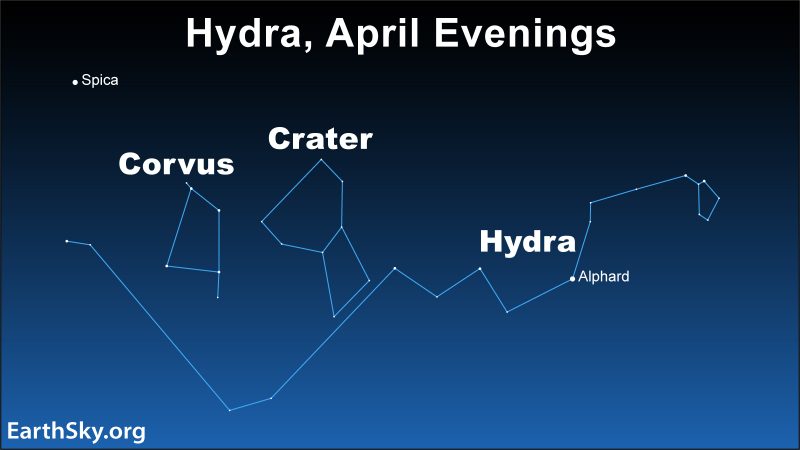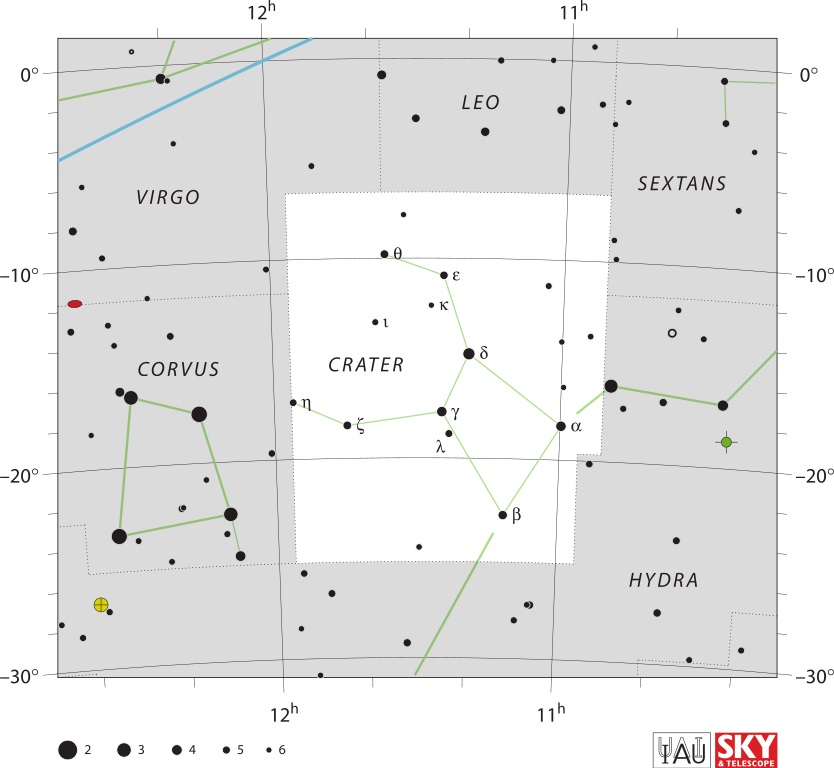
Crater the Cup is one of two constellations riding on the back of Hydra the Water Snake. You can spot Crater, along with Corvus the Crow, on April evenings toward the southwestern horizon. For those in the Southern Hemisphere, Hydra is slithering down toward the western horizon with Crater and Corvus clinging to the north side of the Water Snake.
Try Stellarium for a more precise star charts from your location.
Last chance to get a moon phase calendar! Only a few left. On sale now.
Mythology of Crater the Cup
In mythology, Crater was the cup from which Apollo drank. Apollo was a well-known Greek god whose job was to carry the sun across the sky each day. As you can imagine, it was a hot and laborious task. So, Apollo asked his pet crow, Corvus, to fetch him some water to drink because he was tired and overheated. But Corvus was not a good pet and did not do as Apollo wished.
Corvus flew away on his mission, and while gone he saw a tree with berries. Then he spent a couple of days eating the berries before finally returning with the water. Also, he brought along a water snake, making up a story that the water snake attacked him and this was the reason for his delay. However, Apollo didn’t believe his lie and placed him in the sky by the cup. Now Corvus the Crow always has the cup in his sights but can never drink from it himself.
Locating Crater
If you draw a line between the bright stars Spica in Virgo and Regulus in Leo, Crater is about midway between them and to the south.
Of course, if you’re familiar with Hydra the Water Snake, you can find Crater toward the middle of the snake’s body, placed upon its back.
The stars of Crater
As a matter of fact, none of Crater’s stars are particularly bright. Crater the Cup’s brightest star is Delta Crateris at magnitude 3.56. Delta Crateris lies at a distance of 195 light-years. Gamma Crateris is a magnitude 4.05 star lying 89 light-years away. Slightly dimmer is Alkes, or Alpha Crateris, at magnitude 4.08. It lies 174 light-years away. The Beta star is a dim 4.46 magnitude at a distance of 266 light-years.
So all of these stars are hard to see in urban and other light-polluted locations. Thus, you’ll want to find a dark-sky location near you to hunt down the Cup.

Bottom line: Crater the Cup is a dim constellation that sits upon the back of Hydra the Water Snake. You can see Crater best on April evenings from a dark-sky site.
The post Crater the Cup sits upon Hydra’s back first appeared on EarthSky.
from EarthSky https://ift.tt/Mh1id5N

Crater the Cup is one of two constellations riding on the back of Hydra the Water Snake. You can spot Crater, along with Corvus the Crow, on April evenings toward the southwestern horizon. For those in the Southern Hemisphere, Hydra is slithering down toward the western horizon with Crater and Corvus clinging to the north side of the Water Snake.
Try Stellarium for a more precise star charts from your location.
Last chance to get a moon phase calendar! Only a few left. On sale now.
Mythology of Crater the Cup
In mythology, Crater was the cup from which Apollo drank. Apollo was a well-known Greek god whose job was to carry the sun across the sky each day. As you can imagine, it was a hot and laborious task. So, Apollo asked his pet crow, Corvus, to fetch him some water to drink because he was tired and overheated. But Corvus was not a good pet and did not do as Apollo wished.
Corvus flew away on his mission, and while gone he saw a tree with berries. Then he spent a couple of days eating the berries before finally returning with the water. Also, he brought along a water snake, making up a story that the water snake attacked him and this was the reason for his delay. However, Apollo didn’t believe his lie and placed him in the sky by the cup. Now Corvus the Crow always has the cup in his sights but can never drink from it himself.
Locating Crater
If you draw a line between the bright stars Spica in Virgo and Regulus in Leo, Crater is about midway between them and to the south.
Of course, if you’re familiar with Hydra the Water Snake, you can find Crater toward the middle of the snake’s body, placed upon its back.
The stars of Crater
As a matter of fact, none of Crater’s stars are particularly bright. Crater the Cup’s brightest star is Delta Crateris at magnitude 3.56. Delta Crateris lies at a distance of 195 light-years. Gamma Crateris is a magnitude 4.05 star lying 89 light-years away. Slightly dimmer is Alkes, or Alpha Crateris, at magnitude 4.08. It lies 174 light-years away. The Beta star is a dim 4.46 magnitude at a distance of 266 light-years.
So all of these stars are hard to see in urban and other light-polluted locations. Thus, you’ll want to find a dark-sky location near you to hunt down the Cup.

Bottom line: Crater the Cup is a dim constellation that sits upon the back of Hydra the Water Snake. You can see Crater best on April evenings from a dark-sky site.
The post Crater the Cup sits upon Hydra’s back first appeared on EarthSky.
from EarthSky https://ift.tt/Mh1id5N

Aucun commentaire:
Enregistrer un commentaire